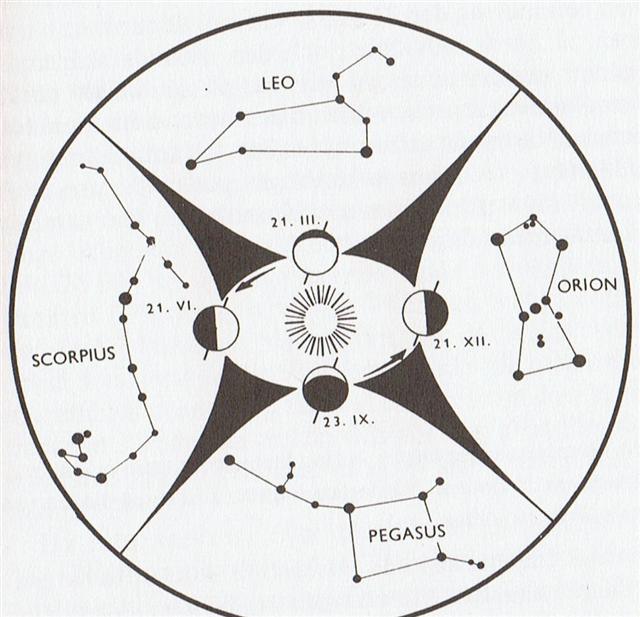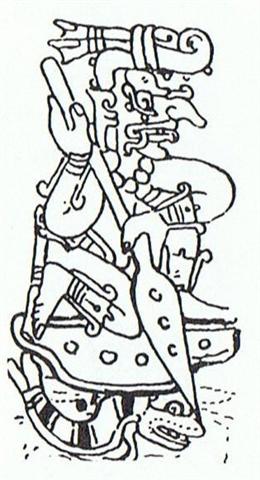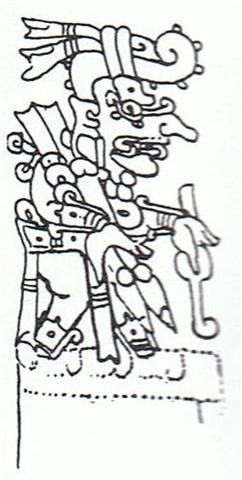Once again. I assume Te Kioe Uri in Manuscript E emphasizes the 'confined' position of the Sun King in the night in contrast to his position on the northern (daytime) coast, where Oromanga was his place of birth:
|
22 |
Oromanga |
23 |
Hanga Moria One |
24 |
Papa O Pea |
25 |
Ahu Akapu |
|
birthplace of the new king |
residence of the current king |
residence for the future king |
residence for the abdicated king |
|
26 Te Pito O Te Kainga |
In other words, the southern coast could reflect - like the nakshatra stars in the night - where the Sun was at the front side of the year. If, for instance Leo was observed in the March night, it meant the Sun was at the opposite side of the year, in daytime September:

A little rat is the opposite of a big cat and Te Kioe Uri could therefor be an asterism visible in the September night.
Metoro never said kioe when reading the rongorongo texts for Bishop Jaussen. Instead he mostly said kiore at the figure at left in e.g. *Ca14-17:
| March 30 |
31 |
April 1 (91) |
2 |
3 |
4 (460) |
| September 29 |
30 (273) |
October 1 |
2 |
3 |
4 (277) |
 |
 |
 |
 |
 |
 |
| *Ca14-12 |
*Ca14-13 |
*Ca14-14 |
*Ca14-15 |
*Ca14-16 |
*Ca14-17 |
| te kihikihi |
o te henua - kua haga hia |
kua pua |
te vero |
te henua |
kiore - te henua |
| ξ Phoenicis (9.0), ρ Tucanae (9.1), Deneb Kaitos, η Phoenicis (9.4) |
Achird (10.7) |
ρ Phoenicis (11.2), η Andromedae (11.4) |
Cih, λ Tucanae (12.4) |
no star listed (13) |
no star listed (14) |
| ι Crucis (192.3), β Muscae (192.5), Mimosa (192.9) |
no star listed (193) |
κ Crucis (194.4), ψ Virginis (194.5), μ Crucis, λ Crucis (194.6), Alioth (194.8) |
Minelauva (195.1), Cor Caroli (195.3) |
δ Muscae (196.5), Vindemiatrix (196.8) |
13h (197.8) |
| ξ¹ Centauri (197.1), ξ² Centauri (197.9) |
Here we can see an opening with a little henua in front. I guess this design - like the corresponding Egyptian night view with Nut, Shu, and Geb - is expressing the idea of 'dawn'. The mists of early dawn are like cloud covers which gradually disperse as the day grows. We can compare this situation with that of the apparently much younger figure in Ca2-23, which gives the impression of being more confined:
| May 8 |
9 |
10 (130) |
11 |
| November 7 |
8 |
9 |
10 (314) |
 |
 |
 |
 |
| Ca2-22 |
Ca2-23 |
Ca2-24 |
Ca2-25 (51) |
| te Rei - pa hia mai |
kiore i te henua |
niu - kupega hia mai |
tu te niu - ku huki |
| Zibal (48.0) |
τ Arietis (49.7) |
Algenib Persei (50.0), ο Tauri (50.2), ξ Tauri (50.8)
Gienah
|
no star listed (51) |
| μ Lupi, γ Tr. Austr. (231.3) |
ο Cor. Borealis (232.0), δ Lupi (232.1), φ¹, ν² Lupi (232.2), ν¹ Lupi (232.3), ε Lupi (232.4), φ² Lupi (232.5), Pherkad (232.6), η Cor. Borealis (232.8), υ Lupi (232.9) |
Alkalurops (233.1) |
Nusakan (234.0), κ¹ Apodis (234.3), ν Bootis (234.7) |
Moreover, the slightly curved henua in front is quite different in kind from that in *Ca14-16. I guess it could refer to a canoe. In Polynesia a canoe (a ship) was thought of as a piece of earth, like a little island floating on the vast ocean:
... 4 March 1779. The British ships are again at Kaua'i, their last days in the islands, some thirteen months since their initial visit. A number of Hawaiian men come on board and under the direction of their women, who remain alongside in the canoes, the men deposit navel cords of newborn children in cracks of the ships' decks (Beaglehole 1967:1225).
For an analogous behavior observed by the missionary Fison on the Polynesian island of Rotuma, see Frazer (1911, 1:184). Hawaiians are connected to ancestors (auumakua), as well as to living kinsmen and descendants, by several cords emanating from various parts of the body but alike called piko, 'umbilical cord'. In this connection, Mrs. Pukui discusses the incident at Kaua'i:
I have seen many old people with small containers for the umbilical cords... One grandmother took the cords of her four grandchildren and dropped them into Alenuihaha channel. 'I want my granddaughters to travel across the sea!' she told me.
Mrs. Pukui believes that the story of women hiding their babies' pikos in Captain Cook's ship is probably true.
Cook was first thought to be the god Lono, and his ship his 'floating island'. What woman wouldn't want her baby's piko there?
The very common glyph type henua has various shapes, which probably all convey information of various kinds. Early I was rather convinced the basic idea was 'tree':
|
GD37
|
henua |
This glyph type was unquestionably associated with henua by Metoro. He may have meant something like 'the nourishing land'. |
| A few preliminary remarks and imaginations:
1. Perhaps this type of glyph is an image of a wooden staff (kouhau). Such were used in different circumstances: measuring, memory aids (cutting marks in the wood), sign of power etc.
"He [Eric Thompson] established that one sign, very common in the [Mayan] codices where it appears affixed to main signs, can be read as 'te' or 'che', 'tree' or 'wood', and as a numerical classifier in counts of periods of time, such as years, months, or days.
In Yucatec, you cannot for instance say 'ox haab' for 'three years', but must say 'ox-te haab', 'three-te years'. In modern dictionaries 'te' also means 'tree', and this other meaning for the sign was confirmed when Thompson found it in compounds accompanying pictures of trees in the Dresden Codex." (Coe)
The possible connection between a measuring staff and a numercial classifier for time periods made me early on in these studies conclude it was the origin of the glyph type henua. At tagata ('a fully grown season') I have therefore suggested that henua glyphs (here below Eb3-3 and Eb5-6) were used in the meaning 'season', 'period', etc:
|
In general I do not disagree with what I above wrote in my preliminary glyph type dictionary. But I would like to add the perspective of the feathers from Tagaroa:
... Ta'aroa sat in his heaven above the earth and conjured forth gods with his words. When he shook off his red and yellow feathers they drifted down and became trees ...
Tane was the god of trees and if the trees originated from feathers, then both feathers and trees should signify the halfyear of 'Earth' in contrast to the halfyear of 'Sea' - land contra water. The design at the back side of Pachamama seems to agree, with a 'feather' Sun on one side and a 'rain' Sun on the other:
.jpg)
Thus we can guess the sign for earth (henua) was borrowed from the sign for tree. The periods of 'Land' should be counted in kind, i.e. by using 'trees'.
If the feathers originated from Tagaroa, then he was older than Tane. But this we already knew from the myths:
... Long ago in the very beginning of time there dwelt within a shell an infant god whose name was Ta'aroa. He was Ta'aroa the unique one, the ancestor of all gods, the creator of the universe whose natures were myriad, whose backbone was the ridgepole of the world, whose ribs were its supporters. The shell was called Rumia, Upset.
In the Egyptian night side view we can find 'water bubbles' earlier than air at right, where the Sun ship has stranded on the left elbow of Nut:

The 2nd Mayan day sign, after Imix the Sea-dragon, was Ik which means 'air'.
In the 'Rain God' sequence we can imagine Imix carrying the canoe of the Rain God on his back in the first panel and in the second panel see the Rain God in midair (I have reversed the pictures so time will flow from left to right):
 
IO
Io dwelt within the breathing-space of immensity. // The universe was in darkness, with water everywhere. // There was no glimmer of dawn, no clearness, no light.
And he began by saying these words,
That he might cease remaining inactive:
'Darkness, become a light-possessing darkness.' And at once a light appeared. He then repeated these self-same words in this manner,
That he might cease remaining inactive:
'Light, become a darkness-possessing light.' And again an intense darkness supervened. Then a third time He spake, saying:
'Let there be one darkness above. Let there be one darkness below. Let there be a darkness unto Tupua. Let there be a darkness unto Tawhito. A dominion of light. A bright light.' And now a great light prevailed.
Io then looked to the waters which compassed him about, and spake a fourth time, saying:
'Ye waters of Tai kama, be ye separate. Heaven be formed.' Then the sky became suspended.
'Bring forth thou Te Tupua horo nuku.' And at once the moving earth lay stretched abroad.
(Tiwai Paraone, New Zealand, c. 1880, and translated by Hare Hongi.)
More than fifty years after Christianity reached New Zealand it was suddenly disclosed by certain Maori elders that the pantheistic mythology hitherto revealed was not in fact the full story, and that according to an esoteric or 'higher' learning - withheld till then because of its sanctity - the Maori did have a single, Supreme Creator, whose name was Io.
The first reference in print to Io seems to have been made in 1876, by C. O. Davis, who said a member of the Ngapuhi tribe had told him 'that the Maoris in olden times had worshipped a Supreme Being whose name was so sacred that none but a priest might utter it at certain times and places ... The only complete account was given much later, in a manuscript dictated by the Maori elder Te Matorohanga and published in 1913 ... But both this elder and his scribe Te Whatahoro were converted to Christianity long before the manuscript was composed.
The little word 'io' or 'kio', as Buck points out in an amused survey of the principal evidence and claims ... can sometimes mean the squeak of a rat or bird, at other times muscular twitches of the body that were regarded as omens by the Maori. Even so, Io-Jehovah caused some excitement in an age which wished to persuade itself that primitive peoples had really been Believers all along, and His revelation soon led to further discoveries elsewhere in Polynesia - notably in the Tuamotu, where Stimson believed as late as 1933 that he had unearthed a cult of 'Kiho'.
(Antony
Alpers, Legends of the South Seas.)
|
The idea of 'the squeak of a rat or bird, at other times muscular twitches of the body that were regarded as omens' may have been known by Metoro, because he said kikiu at the very first glyph of this kind in the C text:
| Kikiu Kikiu. 1. Said of food insufficiently cooked and therefore tough: kai kikiu. 2. To tie securely; to tighten the knots of a snare: ku-kikiu-á te hereíga, the knot has been tightened. 3. Figuratively: mean, tight, stingy; puoko kikiu. a miser; also: eve kikiu. 4. To squeak (of rats, chickens). Kiukiu, to chirp (of chicks and birds); to make short noises. The first bells brought by the missionaries were given this name. Vanaga.
Kiukiu (kikiu). 1. To resound, to ring, sonorous, bell, bronze; kiukiu rikiriki, hand bell; tagi kiukiu, sound of a bell; kikiu, to ring, the squeeking of rats; tariga kikiu, din, buzzing; hakakiukiu, to ring. Mgv.: kiukiu, a thin sound, a soft sweet sound. 2. To disobey, disobedience; mogugu kiukiu, ungrateful; ka kikiu ro, to importune. Churchill. |
Or he may have meant the 'Rat' was securely tied up to a piece of earth - 'squeeking' like Andromeda.at a corner of the Pegasus Square 18 days earlier:
... Hence the blameless Andromeda came to be chained to a rock to atone for the sins of her mother, who watched from the shore with bitter remorse. The site of this event is said to have been on the Mediterranean coast at Joppa (Jaffa), the modern Tel-Aviv. As Andromeda stood on the wave-lashed cliffs, pale with terror and weeping pitifully at her impending fate, the hero Perseus happened by, fresh from his exploit of beheading Medusa the Gorgon. His heart was captivated by the sight of the frail beauty in distress below ...
|









.jpg)






